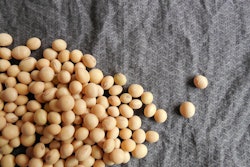Commodity and equity markets were lower overnight as broad-based bearish sentiment continues to entrench the global view. In grains, soybeans were down 6 cents a bushel while corn and wheat gave up 4-cents in the night session. Overnight trade showed stock markets in Japan and Europe on the downside, with S&P futures off 1.7 percent. Oil also was lower posting a $1.40 a barrel drop or 3 percent.
Grains came under pressure in the night session following USDA’s crop progress report showing another uptick in soybean ratings from 61 percent good-to-excellent last week to 63 percent this week. Harvest pace for beans was pegged at 7 percent while corn improved to 10 percent cut. With the brunt of harvest still ahead, it would seem that any rallies in the next 2 weeks would be short-lived. Weather looks to be mostly ideal in the coming weeks showing warm and dry weather over much of the Midwest which should aid late-season development and harvest.
For wheat, Monday saw some positive price moves thanks to lingering dryness in the former Soviet Union, where farmers are planting ahead of the 2016 harvest, and in Australia, where wheat needs moisture for its final grain fill. Ongoing dryness is expected in about one-third of former Soviet Union and Australian wheat areas for the next two weeks.
In South America, a new round of rains due next week will weaken the hot, dry air mass that has been gripping Brazil's main farm belt. A slow-moving cold front expected to vacate the waterlogged southern grain state of Rio Grande do Sul from Sept. 26 will begin to push into Parana, Mato Grosso do Sul, and Sao Paulo initially. By the second week of October the front is expected to create showers over Mato Grosso, Minas Gerais and Goias. “The (precipitation) volumes will not be heavy, but will allow soil moisture levels to improve, guaranteeing favorable conditions for the planting of the new soybean crop," Somar senior meteorologist Marco Dos Santos said on Monday. The official planting season for soybeans started on Sept. 15 and typically continues until early December. The earlier Brazilian grain farmers can get their crops planted, the better the prospects for planting their winter corn, wheat and cotton crops before the rains retreat in the early months of 2016.
Crude oil prices (GCLX5 / QMX5) were off 3 percent on Tuesday, reversing a steep rally the previous day of nearly 4 percent. Oil continues to be plagued by sky-high surpluses and uncertainty over whether global demand will cut into the stockpiles. There is evidence that U.S. shale production is starting to feel the pinch of oil prices near six-year lows, which has prompted the International Energy Agency (IEA) to issue more bullish forecasts for the market balance next year. But uncertainty is running high over the outlook for demand in top consumers such as China, as well as the resilience of the U.S. economy following the Federal Reserve's policy meeting last week.
S&P futures (ESZ5) were solidly lower in the night session giving up 1.7 percent as much of Asia and Europe posted weaker closes in stocks overnight. U.S. assets got a boost Monday as a fourth Fed official talked up prospects for higher rates in 2015, just days after the central bank jolted investors by citing global market turmoil and a slowdown in China as reasons for standing pat. Several technical charts are sounding warning signals that the worst of equities turmoil may not be over.














